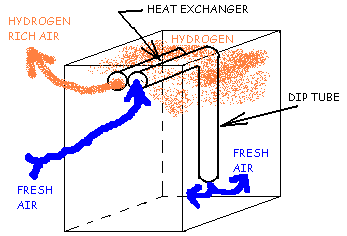HYDROGEN VENTILATION USING HIGH VENTS, DIP TUBE AND HEAT EXCHANGER
A battery enclosure using high vents, a riser tube and a heat exchanger is shown in Figure 5. This type of ventilation system makes complete use the properties of natural convection as described in Example 2. Placement of the inlet and outlet vent tubes at the same height (high on the wall) prevents some of the unwanted thermal convection described in Example 2 which causes too much air flow and excessive temperature extremes inside the box. A heat exchanger transfers heat from the warmer vent tube to the cooler vent tube, reducing the temperature difference between the tubes, which reduces thermal convention even more. Since there is no height difference between the outlets, and very little temperature difference, airflow driven by thermal convention is virtually eliminated. Only the presence of light-density hydrogen-rich-air forces air out of the box, drawing fresh air in the dip tube. The airflow is proportional to the concentration of hydrogen, and the more hydrogen is generated, the more ventilation occurs regardless of air temperature.
FIGURE 5
Hydrogen Ventilation Using High Vents, Dip Tube and Heat Exchanger.
All the features described in EXAMPLE 5 are available in the CONVECTION H2VENT™ from ZOMEWORKS CORPORATION (U.S. Patent# 5660587).

